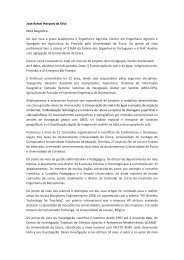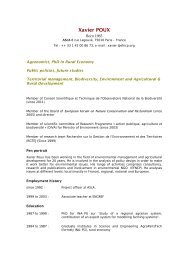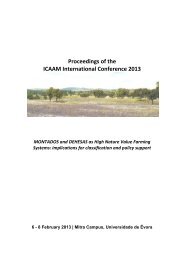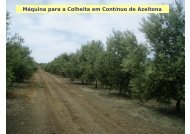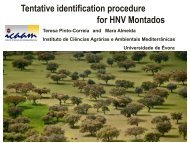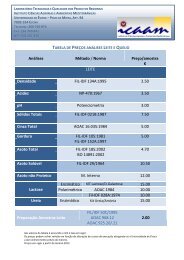Nucleic Acids as Therapeutic Agents - icaam
Nucleic Acids as Therapeutic Agents - icaam
Nucleic Acids as Therapeutic Agents - icaam
You also want an ePaper? Increase the reach of your titles
YUMPU automatically turns print PDFs into web optimized ePapers that Google loves.
<strong>Nucleic</strong> <strong>Acids</strong> <strong>as</strong><strong>Therapeutic</strong> <strong>Agents</strong>
The major limitation of the practicalutilization of nucleic acids <strong>as</strong> therapeuticagents is delivering these compounds toinside their target cells
Fig. 11.1 Inhibition of translation ofspecific mRNAs by antisense (AS)nucleic acid molecules.Promoter and polyadenylationregions are p and pa, respectively;the intron is indicated by the letter A;and the exons are indicated bynumbers (1 and 2).(A) An antisense cDNA is clonedinto an expression vector and theconstruct is transfected into a cell,where the antisense RNA issynthesized. Antisense RNAhybridizes to target mRNA, andtranslation is blocked.(B) An antisense oligonucleotide isintroduced into a cell, and after ithybridizes with the target mRNA,translation is blocked.AB
Fig. 11.5 A liposome carrying a nucleic acid. In one experimentused to control psori<strong>as</strong>is with an antisense oligo (15 long) vs. IGF-1 receptors. Tested different oligos. Best ones reduced IGF-1receptors by ~50%.
Fig. 11.7 Schematic representation of the reverse transcription of retroviralRNA (red) to produce ds DNA (minus strand is light blue and plus strand isdark blue). Step 1, a tRNA primes synthesis of the minus strand. RNA showsU3 and U5 elements and polypurine tract (PPT). Step 2, a complete RNA-DNAduplex is formed. Step 3, RN<strong>as</strong>e H digests the vRNA in the RNA-DNA duplexinto small pieces. Step 4, ds DNA copy of the vRNA which can exist <strong>as</strong> aprovirus integrated into a cell’s DNA. To block the formation of the minusstrand and hence the synthesis of a ds DNA version of the virus, an antisenseoligonucleotide that hybridizes to the PPT region is added. This protectsagainst retroviruses in mice.
Fig. 11.8 Two-dimensional representation of A hammerhead and B hairpinribozyme-mRNA substrate complexes. Naturally-occurring catalytic RNA ~40-50 nucleotides long. Introduced by transfection of ds DNA version on a vector.The mRNA substrates and ribozymes are shown in red and blue, respectively.Abbreviations: Y, a pyrimidine nucleotide (C or U); R, a purine nucleotide (A orG); H, any nucleotide except G; B, any nucleotide except A; V, any nucleotideexcept U; N and N’, any complementary nucleotides. An arrow indicates thepoint of mRNA cleavage.AB
Thom<strong>as</strong> Cech and Sidney Altman shared the 1989Nobel Prize in chemistry for discovering the catalyticproperties of RNA
Fig. 11.11 Overview of the SELEX procedure for selecting aptamers with ahigh affinity to a target molecule (often a protein). Selected aptamers (15-40nucleotides long) are typically cycled through this procedure 5 to15 times. 3’region binds reverse transcript<strong>as</strong>e primers. 5’ region h<strong>as</strong> a site for a PCRprimer. RNA is produced using T7 polymer<strong>as</strong>e. Initial pool ~10 16 variants.Aptamer = oligonucleotidethat binds well to proteins,amino acids, etc.
V<strong>as</strong>cular endothelialgrowth factor
Fig. 11.12 Schematic representation of protein VEGF whichcontains both a receptor-binding domain and a heparin-bindingdomain. VEGF stimulates growth of new blood vessels insenescing retinal pigment epithelial cells, however, when the bloodvessels don’t form properly, there is scarring and loss of vision inthe macular region of the retina. An aptamer that binds to VEGF isinjected into the eye and suppresses age-related maculardegeneration. Approved by FDA in 2004.
Interfering RNAs• Addition of ds RNA to animal cells reducesexpression of the gene from which the ds RNAsequence is derived• This h<strong>as</strong> been termed RNA interference or RNAi,and occurs naturally. RNAi may protect animalsand plants from viruses, and may also be animportant regulatory mechanism• Following introduction of dsRNA into a cell, it iscleaved into ssRNA 21-23 nucleotides long. Theseoligos bind to and cleave mRNA. Transfection ofmammalian cells in culture with duplexes of 21-nucleotide RNA is also effectiveSee page 440
Fig. 11.13 Overview of the process of RNA interference. Followingintroduction of double stranded (ds) RNA into a cell, the Dicer complexbinds to the RNA and cleaves it to a siRNA containing approximately 21-bp.The antisense strand (red) becomes part of the RISC complex, directing thecleavage of the complementary mRNA. A short hairpin RNA encoded on apl<strong>as</strong>mid may be used intead of ds RNA.
Fire and Mello shared the 2006 Nobel Prize fordiscovering RNA interferenceAndrew FireCraig Mello
For specificity keep conc. Below 20 nm1 nucleotide bulge to avoid interferonAvoid UGGCBlunt ended 27 mer or 29 mer shRNA
<strong>Nucleic</strong> Acid Delivery
Fig. 11.19 Schematic representation of the regulation of muscle growth anddevelopment in dystrophic mice by myostation (A) in non-transgenic mice and(B) in transgenic mice that overexpress the protein follistatin. Myostatinnegatively regulates the number of myofibers formed. Muscular dystrophymight be treated by decre<strong>as</strong>ing the impact of myostatin. Follistatin w<strong>as</strong>introduced into mice using adeno-<strong>as</strong>sociated virus.
Gene Doping: non-therapeutic use of gene therapyto enhance athletic performance - possible targets• Use of erythropoietin to incre<strong>as</strong>e red blood cell level• Knock-out of myostatin gene expression; myostatin normallyinhibits muscle growth• Over-expression of insulin-like growth factor 1 which canincre<strong>as</strong>e muscle size and strength• Over-expression of v<strong>as</strong>cular endothelial growth factor toinduce formation of new blood vessels
Fig. 11.20 A conjugate of cholesterol and a siRNA where the cholesterol iscoupled through the 5’-OH of the sense strand of the siRNA. Followinginjection of the complex into mice, cholesterol facilitates uptake of thesiRNA into specific tissues and silencing of apolipoprotein B (which isinvolved in cholesterol metabolism). The antisense strand becomes part ofthe RISC complex and specifies where the mRNA is to be cleaved. In mice,target mRNA w<strong>as</strong> decre<strong>as</strong>ed significantly in the liver and the jejunum (partof the small intestine) thereby reducing serum cholesterol levels.
Fig. 11.21 Use of a nonpathogenic strain of E. coli to deliver siRNAs tocertain tissues. The bacterium w<strong>as</strong> engineered to produce the proteininv<strong>as</strong>in which permits E. coli to enter 1-integrin-positive mammaliancells <strong>as</strong> well <strong>as</strong> the gene HlyA that encodes listerolysin O which permitsthe short hairpin RNAs (shRNAs) synthesized by the bacterium to berele<strong>as</strong>ed inside the mammalian cell. This technique may be used totarget and kill specific cancer cells (in culture and live mice)
Fig. 11.22 Negatively charged siRNAs bind to positively chargedatelocollagen (subunit size ~300 kDa; from calf dermis followingdigestion with pepsin in acid). The complex facilitates delivery ofsiRNAs and protects them against nucle<strong>as</strong>e digestion. Used to deliversiRNA to injected mice.
Fig. 11.23 A single chain Fab fragment directed against a mammaliancell surface (bre<strong>as</strong>t cancer) protein is fused to the positively chargedpolypeptide protamine which binds non-covalently to negativelycharged siRNAs. The Fab fragment acts to deliver the siRNA tospecific cancerous cells. A two chain Fab fragment h<strong>as</strong> also beenused to deliver siRNAs. Used in culture and by injecting directly intotumours.
Fig. 11.24 Schematic representation of the secondary structure of achimeric RNA molecule consisting of an aptamer (binds to a prostratecancer specific antigen) and an siRNA (designed to kill the cancerouscell). The portion of the aptamer that binds to the target protein andthe siRNA portion of the molecule is outlined are shaded.





